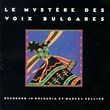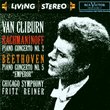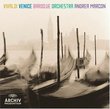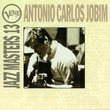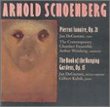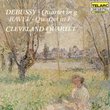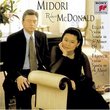| All Artists: Vagn Holmboe, Owain Arwel Hughes, Århus Symphony Orchestra Title: Vagn Holmboe: Symphonies Nos. 1, 3, 10 Members Wishing: 1 Total Copies: 0 Label: Bis Release Date: 9/9/1994 Album Type: Import Genre: Classical Style: Symphonies Number of Discs: 1 SwapaCD Credits: 1 UPCs: 789368013722, 7318590006054 |
Search - Vagn Holmboe, Owain Arwel Hughes, Århus Symphony Orchestra :: Vagn Holmboe: Symphonies Nos. 1, 3, 10
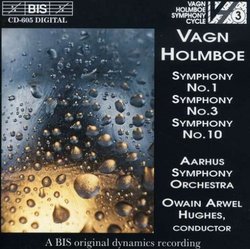 | Vagn Holmboe, Owain Arwel Hughes, Århus Symphony Orchestra Vagn Holmboe: Symphonies Nos. 1, 3, 10 Genre: Classical
|
Larger Image |
CD DetailsSimilarly Requested CDs |
CD ReviewsStunning Performance by Hughes/Aarhus Thomas F. Bertonneau | Oswego, NY United States | 10/27/2000 (5 out of 5 stars) "This disc offers a sampling both from the very beginning and from near the end of Vagn Holmboe's (1909-1996) great cycle of thirteen symphonies. The term "nationalism" has acquired some obnoxious connotations in the 20th century, but it is by no means synonymous with xenophobia, parochialism, or aggression across borders. When William Wordsworth in his poetry or Gustav Holst in his music celebrated the presence of the specifically English countryside, both were working a vein of nationalism. So were Karen Blixen (a.k.a. Isak Dinesen) and Vagn Holmboe in their assimilation of the Danish countryside respectively to narrative prose (See "Sorrow Acre" or "The Ring") and extended symphonic composition. They were exercising what Oswald Spengler called "physiognomic tact," the subject's profound immersion of himself in the local scene, his attunement of the ear to the local tongue, of his body to the local gait and gesture, his sense of placement and direction to the form offered by local pathways and hills and hollows. In just this "physiognomic" manner, Holmboe's First (1935) and Third (1941) Symphonies qualify as intensely "nationalist," that is to say, Danish - or even more specifically, Jutish. The First, scored for chamber orchestra, shows Holmboe pouring his sense of Jutish folkmusic into three rhythmically animated movements that show how much he had learned from Bartók. The Third, subtitled "Sinfonia Rustica," offers two lively outer movements ("Brujdans" and "Bryde Kloster") flanking a substantial variations on the medieval ballad "Skammelse" ("The Shaming"). The example of Bartók is again evident. The Tenth Symphony (1970-71) manifests the later, somewhat more "cosmic" Holmboe. Indeed, after the work's première, critics spoke of "solar flares," "nebulae," "supernovae," and other stellar phenomena. Formally speaking, the Tenth is a gradually unfolding metamorphosis of the plainsong "Dies Irae," which however does not reveal itself in its recognizable outline until the final pages. (It is a kind of "metamorphosis-in-reverse.") Despite the larger scale and the increased sophistication of the procedures, the Tenth is unmistakably by the same composer as the two earlier works. If the Third makes explicit reference to Jutish culture and history, the Tenth too is Danish, calling to mind the cosmological and theological speculations of the Renaissance astronomer Tycho Brahe (who was also a poet). This too, then, is Holmboe exercising his "phyiognomic tact" - as Brahe did - microcosm (man) to macrocosm (universe)." The First and the Tenth are lower points in the cycle, but t Christopher Culver | 07/26/2009 (3 out of 5 stars) "This BIS disc comes from the label's 1990s project to record all of Vagn Holmboe's symphonies as performed by the Aarhus Symphony Orchestra conducted by Owain Arwel Hughes. (Note that the complete cycle has since been reissued as an economical box set.) This particular installment mixes three symphonies from vastly different eras. Two of the symphonies rank as disappointments when considered against Holmboe's symphonic output as a whole. The Symphony No. 1 op. 4 (1935) is a neoclassical symphony with a rhythmic livelyness and prominent use of percussion that might go back to Carl Nielsen. While competently written, it is nonetheless an immature work. Holmboe was to develop a very distinctive orchestration style, but here we find him still searching for that individual voice. The Symphony No 10 op. 105 (1972) was written after Holmboe took an interest in "metamorphosis" at the mid-century, a Sibelian concept of organic growth where every development seems the only logical outcome of what preceded. The Tenth opens with a cymbal crash, then proceeds into a curious and very sparse harmonic world somewhat reminiscent of Gubaidulina's symphony "Stimmen... Verstummen..." While the first movement is exciting, Holmboe loses me in the latter two movements. There are long pauses which interrupt the smooth process of metamorphosis and the material is exceedingly spare. It certainly doesn't maintain the high level of the Eighth and Ninth. The one truly great piece here is the Symphony No. 3 op. 25 "Sinfonia Rustica" (1941). In his early maturity, Holmboe was a great admirer of Bartok, and here Holmboe follows the Hungarian master's love of folk sources. Denmark's Jutland peninsula is not a place one would have expected to harbour untapped folkloristic resources in the middle of the 20th century, but the basis of the Third are quite gripping. The first movement is a riotous country dance, while the very long second unfolds as a series of grim variations on the folksong "Skammelsen". The third movement makes an elegant synthesis of the first two. The Third features excellent symphonic writing on top of vigorous and healthy folk material, and I come back to it fairly often among Holmboe's work. Holmboe is a composer worth getting acquainted with, but the best introduction is probably the Symphony No. 8. But the BIS box set is attractively priced, and in general his symphony work is at a high level, so get them all." 10 Is Worth Hearing Karl W. Nehring | Ostrander, OH USA | 07/19/2009 (4 out of 5 stars) "Composer Vagn Holmboe was born in the Jutland region of Denmark (ex-philosophy majors may recall the "Jutland preacher" of Kierkegaard's Either/Or), while conductor Owain Arwel Hughes is a Welshman. These CDs are volumes 3 and 4 in a Holmboe cycle being undertaken by BIS. If you have not yet encountered Holmboe's symphonies, I would recommend starting with the CD containing 8 and 9, both of which are rich orchestral works that sound good on first hearing and invite repeated listening to absorb their aesthetic content.
The other CD gets off to an unpromising start, as 1 and 3 are pleasant but do not, at least to these ears, bear repeated listening. However, 10 is much more interesting, making the disc worth purchasing if you have been captured by 8 and 9 and want to explore more of the Jutland landscape." |

 Track Listings (9) - Disc #1
Track Listings (9) - Disc #1